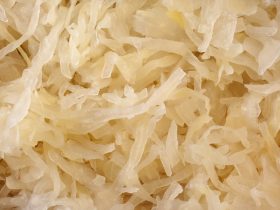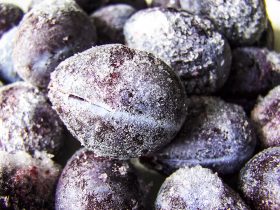Figs are the edible off-shoots of a fruit-bearing tree traceable to the mulberry family of plants. Cultivated throughout most of Asia and parts of the Middle-east, figs have been popular in human cuisine for hundreds of generations1.
Because of the relatively small size of figs as well as the ease at which they are farmed and harvested, it is commonplace for markets and farmers to sell them in rather large amounts at once, and as such, the specific storage method needed to preserve these figs is brought into question.
Yes. Figs can be frozen, though certain factors will come into play that may or may not affect their particular shelf-life while stored in your freezer. It is also important to note that, unless otherwise dried beforehand, figs will suffer from a degradation of texture and taste after being frozen.
Do Dried Figs Last Longer than Fresh Figs?
As the presence of water is a major factor in whether bacteria and fungi are capable of developing colonies in foodstuffs, drying your organic produce is an excellent way to extend the length of time at which they remain safe to eat.

This is doubly so for figs, of which their particular nutrient makeup creates a perfect food source for these microbial life forms. Once dried either through direct mechanical dehydration or exposure to the sun for extended periods, they are often stored in an air-tight bag or container, further insulating them from microbiological life and thus keeping them shelf-stable.
Apart from this, dehydration of the figs will also affect their own internal enzymes, keeping them from spoiling from their own enzymatic action.
How Long Do Figs Last in the Pantry?
It is important to note that simply leaving organic produce out in your pantry entirely untreated is a poor way to store them, and as such will cause them to spoil very quickly. This is even more applicable to figs that have not been dried, as the room-temperature environment of your cupboard or pantry is highly conductive to bacteria and fungi2.
In order to store figs in the pantry, ensure that they are kept in an air-tight container free of any excess moisture. Place this container in a dark and cool corner of your pantry or cupboard and make sure that the area is free of any insects that may be present.
Direct sunlight will also compromise the quality of the figs, and so it is a good idea to keep it far away from any sources of light such as a bulb or an open window.
Stored in the best possible conditions in your pantry, figs will last up to three days before spoiling.
Is it Better to Refrigerate Figs or to Freeze Them?
This is entirely an individual question as both of these storage methods present their own benefits and drawbacks.
The primary factor to consider is the length of time you wish to keep the figs unspoiled. If choosing to store the figs for up to a week, placing them in the fridge is the ideal option as it will not degrade their quality as well as precludes the need to defrost your fruit should you choose to retrieve it.
On the other hand, should your window of storage for the figs be a longer period of up to eight months, freezing is the best way to go.
If choosing to freeze your figs instead of simply placing them in the refrigerator, it is a good idea to note that they will suffer some degradation in their quality and taste, and that defrosting them may take some time, especially if the proper procedures are not followed.
An alternative method is to simply freeze half of your batch of figs while placing the other half within your refrigerator for more immediate use, moving the frozen batch to the refrigerator once you have run out of readily-available fruit.
How to Refrigerate Figs
Refrigerating figs is a far simpler method than choosing to freeze them. To begin, you will only require a resealable plastic pouch and a single piece of tissue paper.
Simply place the figs evenly through the plastic pouch, taking care not to rupture them if they were purchased whole. Ensure that the bag is free of moisture from within and that the figs have been cooled to room temperature, as condensation within the bag will hasten the spoilage of your figs.
Slide a thin sheet of tissue paper in the bag so as to act as a moisture absorbent in the event that this may occur. Push out any excess air within the bag and seal completely.
Leave the bag of figs in the deepest part of your fridge away from any area where they may be squished by other items being refrigerated. It is also advisable to keep the figs away from fans or vents, as these may introduce moist air into the bag.
How to Freeze Figs
Far more labor intensive than simply refrigerating the figs, freezing your figs will require a parchment or wax paper lined baking sheet, a freezer-safe resealable bag and a freezer capable of reaching temperatures at or below 32°F.
First, inspect the figs for any signs of spoilage or mechanical damage that may have occurred during transport. Discard any fruits that appear to be spoiled or otherwise compromised in some way.
After selecting your freezing candidates, place them on the baking sheet with an even space between each individual fruit so as to prevent them from freezing into a single chain. Place the baking sheet in your freezer for two hours.
Note that this step is entirely optional, but will allow you to retrieve your desired amount from the freezer without thawing the entire batch.
After two hours have passed, take the baking tray from the freezer and move the fruits to your resealable freezer bag. Push out any excess air inside with your fingers and seal it.
Leave the figs in the freezer for as long as eight months, though their quality will begin to degrade far sooner than this point in time.
Signs that Figs have Gone Bad
Like all organic produce, figs are constantly at risk of being colonized by microorganisms as well as spoiling from their own internal enzymatic mechanisms. Fortunately, it is quite easy to tell if a fig has become unsafe to eat.
The clearest sign that figs should not be eaten is an alcohol-like or otherwise sour smell, often indicating that fungi have taken root in the fruit. Dispose of it immediately.
If the flesh has begun to discolor, darken, or otherwise become squishy to the touch, this is also an indication that the fruit has begun to decay owing to its own enzymes and improper storage methods. It is also advisable to throw these fruits away.
References
1. Gustavus A. Eisen, Washington (1901) “The Fig: its History, Culture, and Curing”, Govt. print. off.
2. Elizabeth L. Andress. Ph.D. and Judy A. Harrison, Ph.D. (2014) Extension Foods Specialists. “So Easy to Preserve”, 6th ed. Bulletin 989, Cooperative Extension Service, The University of Georgia, Athens.





Hi, I'm Dom
Dom Eats was started to help other people fall in love with food. While cooking can feel intimidating, it doesn't have to be.